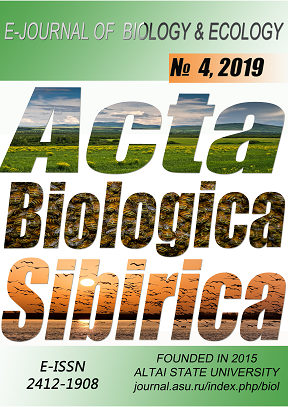Abstract
The results of a long-term comprehensive study of ecological and biological features of urban flora of various habitats of the cities of the Orel (Oryol) oblast: Orel, Mtsensk, Livny, Bolkhov, Maloarkhangelsk, Novosil, and Dmitrovsk are presented in the article. Flora of the city Orel has a population of 913 species, Livny – 786, Mtsensk – 777, Bolkhov – 780, Novosil – 775, Maloarhangelsk – 776, and the Dmitrovsk – 777 species. In the course of research, the taxonomic structure of urban flora is characterized as one of the indicators of floras zonal and ecological-topological confinement. Comparison of complete floristic lists of Orel oblast cities revealed high floristic similarity, which indicates a significant concordance of urban flora and smoothing of zonal distinctions. We also determined large degree of similarity between aboriginal and adventive fraction of flora in various cities. The high correlation between the systematic structure of the dominant families in different habitats is associated with the conformity of regional flora and indicates the close interaction of natural and urban flora.
References
Agafonova LA. 2010. Flora of the Belgorod city [dissertation]. Moscow.
Arep’eva LA. 2011. Features of ruderal urban ecotopes flora of Kursk region. Uchenye zapiski. Elektronnyi nauchnyi zhurnal Kurskogo gosudarstvennogo universiteta 1(17): 48-53.
Arep’eva LA. 2016. Zonal regularities of formation of the Kursk city synanthropic vegetation. Ekologiya 4: 259-263.
Burda RI, Protopopova VV, Fedoronchuk MM, Shevera MV. 2013. Synanthropization of flora and vegetation – a threat to biodiversity (II All-Ukrainian Sci. Conf. “Synanthropization of vegetation cover of Ukraine”). Bulletin of Ukrainian National Academy of Science 2: 77–80.
Emelyanova OYu, Khromova TM. 2015. The natural habitats of the cities of Orel region. Sovremennoe sadovodstvo – Contemporary horticulture 4: 97–104.
Fomina OV, Tokhtar’ VK. 2010. The structure of flora of urban aglomeration of Belgorod: Nauchnye vedomosti. Seriya Estestvennye nauki 21(13): 28–32.
Grigorevskaya AYa, Lepeshkina LA, Zelepukin DS. 2012. Flora of the Voronezh urban district of Voronezh city: biogeographical, landshaftno-ecological, historical aspects: Samarskaya Luka: problemy regional’noi i global’noi ekologii 21(1): 5–158.
Il’minskih NG. 1994. Ecotopological structure of the urban flora. In: Aktual'nye problemy sravnitel'nogo izucheniya flor: Proceed. III Conf on Comparative Floristics. Kungur. St.-Peterburg.
Il’minskikh NG, Tarasova ЕМ. 1992. For the protection of phytogenetic fund of the urban flora. Vestnik Udmurtskogo universiteta 3: 90–93.
Ishbirdina ML, Ishbirdin AR. 1992. Urbanization as a factor of anthropogenic evolution of flora and vegetation. Zhurnal obshchei biologii 53(2): 211–224.
Khromova TM, Emelyanova OYu, Kondrashkin AYu. 2017. Partial flora of ruderal biotopes in towns of Orel region. Sovremennoe sadovodstvo (Contemporary horticulture) 4: 121-130.
Khromova TM, Emelyanova OYu, Tsoi MF. 2016. Ecological assessment of the state of woody plants of the decorative group of cultivated biotopes of the Orel region. Plodovodstvo i yagodovodstvo Rossii XXXXVI: 409-412.
Kostin AE, Avdeev YuM. 2015. Geobotanical research of the biodiversity in the urban environment. Vestnik Krasnoyarskogo gosudarstvennogo agrarnogo universiteta 3: 19–23.
Kuleshova YuV. 2018. About features of biomorphological structure of urbanized territories flora (on the example of Sosnovoborsk, Krasnoyarsk region). Vestnik KrasGAU 2(137): 253–259.
Panasenko NN. 2002. Urban flora of the South-Western non-Chernozem region of Russia (on the example of the Bryansk region’s cities) [dissertation]. Bryansk.
Poluyanov AV. 2001. Flora of Kursk and its environs: some changes in 100 years. In: Materialy nauchogo soveshchaniya “Floristicheskie issledovaniya v Central'noj Rossii na rubezhe vekov”, Ryazan'.
Problemy izucheniya adventivnoi i sinantropnoi flory v regionah SNG. 2003. Proceed. Sc. Conf. Moscow: Tula.
Prokopev EP, Rybina TA. 2010. Experience of monitoring synanthropization and anthropogenic transformation of vegetation of specially protected areas in Tomsk. Vestnik Tomskogo gosudarstvennogo universiteta. Biologiya 3(11): 109–118.
Senator SA, Kostina NV, Saksonov SV. 2013. Diversity dependence of species of urban floras on a number of factors. Vestnik Udmurtskogo universiteta. Seriya Biologiya. Nauki o Zemle 2: 23–29.
Shadrin VA. 2000. Floristic parameters in the estimation of synanthropization of the flora. Sravnitel'naya floristika na rubezhe III tysyacheletiya. St.-Peterburg.
Sklyar EA. 2015. Modern formation trends of adventitious flora fraction in Kursk. Nauchnye vedomosti Belgorodskogo gosudarstvennogo universiteta. Seriya: Estestvennye nauki 21(218): 31-37.
Tokhtar’ VK, Fomina OV. 2013. Peculiarities of formation of floras in an urban environment in the South-West of the Central Russian upland. Belgorod.
Tretyakova AS. 2016. Characteristics of taxonomic structure of flora in the Middle Urals urban areas (Sverdlovsk Region). Samarskij nauchnyj vestnik 1(14): 66-71.
Vinogradova YuK, Maiorov SR, Khorun LV. 2009. Black book of flora of Central Russia. Alien plant species in the ecosystems of Middle Russia. Moscow: GEOS.
Yurtsev BA, Semkin BI. 1980. Studies of concrete and partial floras with the aid of mathematical methods. Botanicheskii zhurnal 65(12): 1706–1718.
Zavidovskaya TS. 2010. Flora of Borisoglebsk. Vestnik Moskovskogo gosudarstvennogo universiteta lesa – Lesnoj vestnik 3: 192-198.
Acta Biologica Sibirica is a golden publisher, as we allow self-archiving, but most importantly we are fully transparent about your rights.
Authors may present and discuss their findings ahead of publication: at biological or scientific conferences, on preprint servers, in public databases, and in blogs, wikis, tweets, and other informal communication channels.
ABS allows authors to deposit manuscripts (currently under review or those for intended submission to ABS) in non-commercial, pre-print servers such as ArXiv.
Authors who publish with this journal agree to the following terms:
- Authors retain copyright and grant the journal right of first publication with the work simultaneously licensed under a Creative Commons Attribution License (CC BY 4.0) that allows others to share the work with an acknowledgement of the work's authorship and initial publication in this journal.
- Authors are able to enter into separate, additional contractual arrangements for the non-exclusive distribution of the journal's published version of the work (e.g., post it to an institutional repository or publish it in a book), with an acknowledgement of its initial publication in this journal.
- Authors are permitted and encouraged to post their work online (e.g., in institutional repositories or on their website) prior to and during the submission process, as it can lead to productive exchanges, as well as earlier and greater citation of published work (See The Effect of Open Access).

